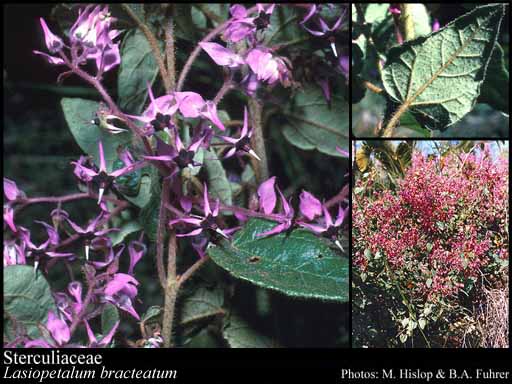This name is not current. Find out more information on related names.
- Reference
- Parad.Lond. pt.69 (1807)
- Name Status
- Not Current







Scientific Description
Common name. Kurrajong Family.
Habit and leaf form. Trees and shrubs, or lianas, or herbs. Self supporting, or climbing. Leptocaul, or pachycaul. Mesophytic, or xerophytic. Leaves alternate; petiolate; non-sheathing; simple, or compound; sometimes palmate. Leaf blades dissected, or entire; when dissected, often palmately lobed; palmately veined, or pinnately veined; cross-venulate. Leaves with stipules. Stipules intrapetiolar; free of one another; caducous, or persistent. Leaves without a persistent basal meristem. Domatia recorded (8 genera); represented by pits (rarely), or pockets (mostly), or hair tufts. Stem anatomy. Nodes tri-lacunar. Secondary thickening developing from a conventional cambial ring.
Reproductive type, pollination. Fertile flowers hermaphrodite (usually), or functionally male and functionally female, or hermaphrodite, functionally male, and functionally female. Unisexual flowers present, or absent. Plants hermaphrodite (usually), or monoecious, or polygamomonoecious.
Inflorescence and flower features. Flowers aggregated in ‘inflorescences’; in cymes. The terminal inflorescence unit cymose. Inflorescences axillary (usually), or terminal, or leaf-opposed, or cauliflorous; complex cymes. Flowers regular (usually), or somewhat irregular; usually 5 merous; cyclic; tetracyclic to polycyclic. Floral receptacle developing an androphore (often), or with neither androphore nor gynophore. Free hypanthium absent. Perianth with distinct calyx and corolla, or sepaline (corolla often absent or reduced); 5–10; 1 -whorled, or 2 -whorled; isomerous (usually). Calyx (3–)5; 1 -whorled; polysepalous, or gamosepalous (usually briefly connate basally); valvate; unequal but not bilabiate; usually persistent. Epicalyx absent. Corolla when present, 5; 1 -whorled; polypetalous (the petals free of one another, but sometimes adnate to the androecial tube); contorted; regular. Petals clawed (usually), or sessile. Fertile stamens present, or absent (female flowers). Androecium 5, or 10, or 25–500. Androecial members branched (commonly), or unbranched. Androecial sequence determinable, or not determinable. Androecial members when branched, maturing centrifugally; free of the perianth, or adnate (the staminal tube often attached to the petals); free of one another, or coherent (the members of the inner whorl often united into a staminal tube, or bundles); 1 - adelphous, or 5 - adelphous (with 5 bundles of 2–3(-10 or more)). The androecial groups opposite the sepals, or opposite the petals. Androecial members (1–)2 -whorled. Androecium exclusively of fertile stamens, or including staminodes (the outer whorl when present staminodial). Staminodes when present, 2–15; petaloid, or non-petaloid. Stamens 5, or 10–500; isomerous with the perianth to polystemonous; or bundles alternisepalous, or oppositisepalous. Anthers dehiscing via longitudinal slits (usually), or dehiscing via pores; extrorse; bilocular; tetrasporangiate. Fertile gynoecium present, or absent (in male flowers). Gynoecium (1–)5 carpelled, or 10–12 carpelled. The pistil when syncarpous, (1–)5 celled, or 10–12 celled (rarely). Carpels isomerous with the perianth, or reduced in number relative to the perianth, or increased in number relative to the perianth. Gynoecium apocarpous to syncarpous; eu-apocarpous to semicarpous, or synovarious, or synstylovarious, or eu-syncarpous, or synstylous; superior. Carpel apically stigmatic; when apocarpous/semicarpous, 2–100 ovuled (to ‘many’). Placentation marginal. Ovary unilocular, or plurilocular; when syncarpous (1–)5 locular, or 10–12 locular (rarely). Gynoecium stylate. Styles 1, or 2; free, or partially joined. Stigmas dry type, or wet type; papillate (when dry), or non-papillate (when wet); Group II type, or Group IV type. Placentation usually axile. Ovules 2–50 per locule (to ‘many’); horizontal, or ascending; apotropous; with ventral raphe, or with lateral raphe; arillate, or non-arillate; hemianatropous, or anatropous.
Fruit and seed features. Fruit fleshy, or non-fleshy (then leathery or woody); an aggregate, or not an aggregate. The fruiting carpel (apocarpous/syncarpous) dehiscent; a follicle, or samaroid. Fruit (when syncarpous) dehiscent, or indehiscent, or a schizocarp. Mericarps when schizocarpic, comprising follicles, or samaroid. Fruit (when syncarpous/non-schizocarpic) a capsule (usually), or capsular-indehiscent (woody). Capsules usually septicidal, or loculicidal. Seeds endospermic (usually), or non-endospermic (e.g. Cola). Endosperm oily, or not oily. Seeds with starch. Cotyledons 2. Embryo chlorophyllous (4/5); straight, or curved. Seedling. Germination phanerocotylar, or cryptocotylar.
Physiology, biochemistry. Aluminium accumulation not found.
Geography, cytology, number of species. World distribution: pantropical and subtropical, extending to Japan and Southern Australia. X = (5-)20(-50)(?). 700 species.
Economic uses, etc. Chocolate (cacao) is obtained from the fermented seeds (‘beans’) of Theobroma cacao. A few genera supply ornamentals (e.g. Brachychiton).
Keys
Western Australian Genera and Families of Flowering Plants — an interactive key
T.D. Macfarlane, L. Watson, N.G. Marchant